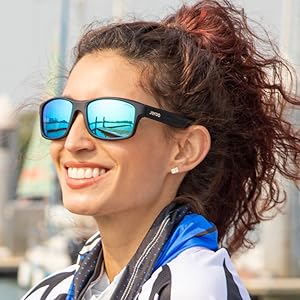Lure fishing originated in the United States in the early 19th century. It was originally used to imitate the movements of small fish, insects and other creatures to attract large fish to take the bait. Later, it gradually developed into an independent fishing method. In the mid-20th century, lure fishing began to become popular in Europe, Japan and other regions. Now more and more people are beginning to like lure fishing. Here are five steps to get started with lure fishing (like a pro)
Step 1: Gear Up Right
Start with a spinning combo:
Rod: Medium-light power, fast-action spinning rod (straight handle).
Reel: 2000–2500 size spinning reel.
This setup is beginner-friendly and versatile—excellent for casting and basic lure control.
Bonus gear: Don’t overlook your eyes—consider wearing a quality pair of polarized sunglasses.
The Jefoo Pailolo JF139 features a lightweight TR90 frame and TAC polarized lenses that block UV400, reduce glare on the water, and help you spot fish more easily—all while resisting saltwater corrosion
Step 2: Line Setup
Go with a braid + fluoro leader combo:
Main line: PE braided line, 0.6–0.8# (10–15 lb test).
Leader: Fluorocarbon line, 1.2–1.5# (6–8 lb test).
The braid gives you sensitivity and casting distance; the fluoro helps you stay stealthy around structure.
Step 3: Pick the Right Lures
Beginner picks:
Beginner-Friendly Options (Easy to cast, easy to catch)
Inline Spinners (e.g., Rooster Tail, Mepps)
Great for trout, bass, and panfish. Flashy and easy to use—just cast and retrieve.
Spoons (e.g., Kastmaster, Little Cleo)
Good for casting distance and attracting strikes with wobble and flash.
Soft Plastic Grubs/Worms (rigged on a jig head)
Deadly on crappie, bass, and bluegill. Keep it simple.
Next-Level Lures
For bigger bites & technique learning
Crankbaits – Hard-bodied lures that dive and wobble. Use shallow or deep-diving models based on where the fish are holding.
Spinnerbaits / Chatterbaits – Flashy, vibrating baits that work great in stained water or around weeds. Big largemouths love them.
Jigs – Versatile and effective. Pair with a soft plastic trailer. Great for flipping, dragging, or skipping under cover.
Topwater Frogs – Weedless and exciting. Cast them over lily pads or weed mats for explosive bass strikes.
Senko-Style Worms (e.g., Gary Yamamoto) – Use on a wacky rig or Texas rig for bass. Lethal in pressured waters.
Swimbaits – Paddle-tail soft plastics that mimic baitfish. Fish them slow and steady along weed edges or open water.
Step 4: Fish Prime Time (aka the "bite windows")
Timing matters:
Morning bite: 5:00 AM – 9:00 AM
Evening bite: 4:00 PM – 8:00 PM
During these “windows” fish are most actively feeding and likely to chase your lures.
Step 5: Target the Right Spots (Find the Fish!)
Match your fishing location to the species you're chasing:
Rocky Shorelines – Smallmouth Bass
Smallies love current, rocks, and structure. Cast crankbaits or jigs along rocky banks and ledges.
Suburban Creeks & Streams – Trout (Rainbow/Brown)
Look for pools and riffles. Great for using inline spinners or small soft plastics on ultralight setups.
Weed Beds / Duckweed Mats – Largemouth Bass
This is froggin' country. Use topwater frogs or punch rigs to trigger explosive strikes in thick vegetation.
Spillways & Sluice Gates – Catfish / White Bass
Fast-moving, oxygen-rich water attracts active feeders. Use blade baits or VIBs for white bass; dead bait or heavy jigs for catfish.
Bridge Pilings / Docks – Crappie / Largemouth Bass
Fish love shade and cover. Try soft plastic grubs or minnows on jig heads for crappie, or skip senkos for bass.
Small Rivers & Backwaters – Bluegill / Panfish
Fun and easy targets for beginners. Tiny spoons, inline spinners, or micro soft plastics work wonders here.
Why the JEFOO Pailolo JF139 Is a Smart Pick
Clear vision: Polarized TAC lenses cut glare and enhance contrast—see fish, structure, and depth more clearly
Eye protection: Certified UV400 blocks 100% of UVA/UVB—essential under strong Arizona sun.
Durability: TR90 frames resist saltwater, sweat, and accidental drops .
Comfort: Lightweight design (approx. 18 g), rubber nose pads, and snug fit mean they stay put during casts and retrieves







